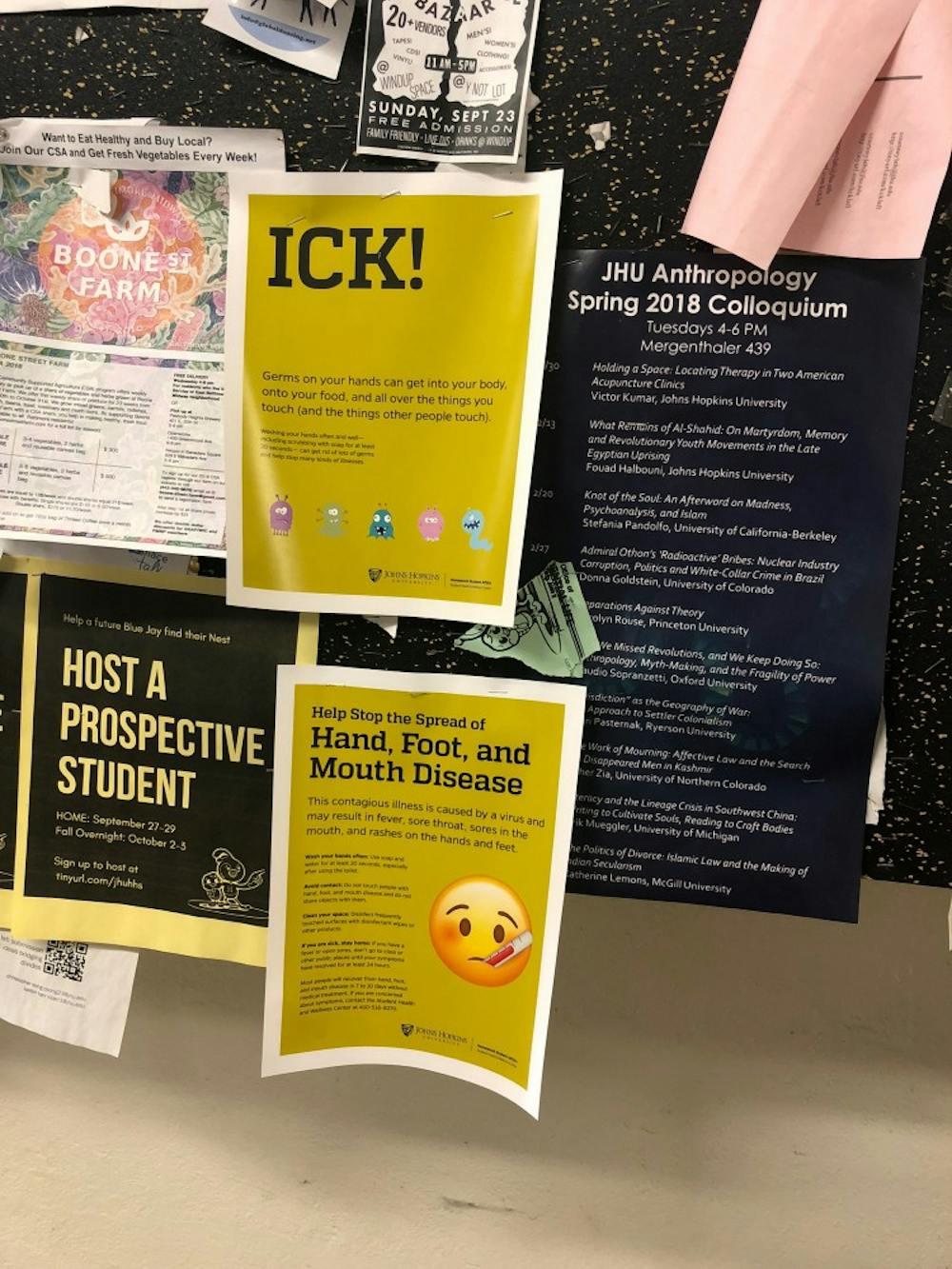Over the past few weeks, media outlets over the country have reported that hand, foot and mouth disease (HFMD) has become increasingly prevalent. A disease primarily found in infants and young children, HFMD has recently spread to students across colleges on the east coast.
The Wall Street Journal reported that Dartmouth College has seen at least 50 cases so far this semester, and students have been wearing surgical masks to prevent the spread of the disease. The Chronicle of Higher Education reported that Lehigh University has seen 116 cases. Hopkins, however, has seen 130 cases as of Wednesday, Oct. 24, according to Student Health and Wellness Center (SHWC) Director Dr. Roanna Kessler.
“It seems to be slowing down in terms of new cases, so hopefully that means the interventions (cleaning, media campaign, etc) have been working,” Kessler wrote in an email to The News-Letter.
Preventative measures that SHWC has taken include posting signs in areas that students frequently walk by such as Keyser Quad and the Gilman Tunnel. The signs inform students that HFMD, which is caused by a virus, can cause a fever, sore throat, sores in the mouth, and rashes on the hands and feet.
“Washing your hands often and well — including scrubbing with soap for at least 20 seconds — can get rid of lots of germs and help stop many kinds of illnesses,” the sign reads.
HFMD, which can be spread through sneezing, coughing and close contact, has spread mostly among underclassmen, particularly through residence and dining halls.
Though senior Resident Advisor (RA) Kush Mansuria has not seen any HFMD cases among his own residents, he noted that several of his fellow RAs have seen their residents come down with HFMD.
“If you’re uninfected, you need to wash your hands thoroughly and often. If you’re infected, you need to stay in your room until cleared by the SHWC,” he wrote in an email to The News-Letter. “Also, avoiding sharing of utensils and cups is essential.”
In a statement to The News-Letter, Executive Director of Housing and Dining Roger Becks described some of the measures that the University has taken to reduce the spread of HFMD.
“Housing and Dining staff have continued to be vigilant in cleaning public spaces, including bathrooms and kitchens, on a more regular basis,“ he wrote. “Hand sanitizer stations have been placed at all major entrances to dining and residence halls.”
Becks added that smaller hand sanitizer bottles are freely available to students in the Wolman and AMR housing offices.
Mansuria thinks that the hand sanitizer stations in residence halls are useful in preventing the spread of HFMD and of disease in general, but he still feels that there are more measures that the University could talk.
“The University is taking steps, but it’s taking a while,“ he wrote. “The other key focus should be the library and Brody.”
According to Becks, the Housing and Dining teams will continue to pursue additional efforts to prevent the spread of the virus. This includes the implementation of Wellness Food to Go cards which allow sick students to get meals without having to enter the dining hall.
According to senior Peter Lazorchak, a member of the varsity swim team, HFMD has spread particularly fast among student-athletes. On the swim team alone, Lazorchak said, he has seen at least four cases so far.
Lazorchak felt that part of why HFMD spreads much faster in athletes is because they tend to spend a lot more time together and sharing common equipment than other students would. He added, however, that the frequency of HFMD occurrences seemed to be reducing due to measures that the Athletics Department has taken.
“The varsity weight room is really cracking down on [HFMD] and cleaning all the equipment way better,“ he said. “And the custodial staff at the Rec Center fully cleaned out our locker rooms last week.”
Becks explained on behalf of SHWC that the disease does tend to affect toddlers and young children much more frequently than it affects adults. He wrote that it was unusual for HFMD to be spreading through college students like it has this semester.
“It is possible that the virus causing the outbreak this year is a different strain from what people were exposed to as children. If that is the case it can spread very quickly since it is as easy to catch as the common cold,” he wrote. “The State lab is currently testing samples from our population to determine the strain of the virus.”





